Call us: 510/845-8835
Fax us: 510/548-0543
A limited edition portfolio of 100 prints are offered for sale, presented in a handmade box for $3,000.
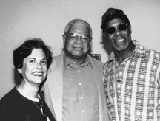

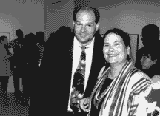

Photos from the Bomani Gallery opening:
1. California Assemblymember Dion Aroner, former Berkeley Mayor Gus Newport, Danny Glover
2. crowded gallery
3. Jos Sances, Mildred Howard
4. Berkeley Art Center Director Robbin Henderson and Howard Levine

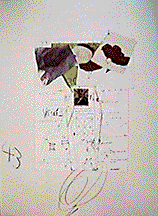
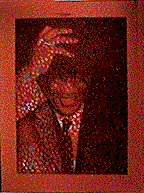
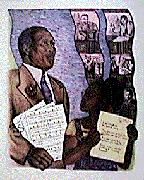
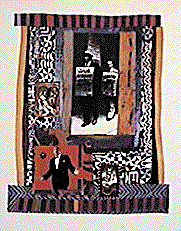
Pictured above:
Jos Sances
Ray Saunders
Mildred Howard
Miranda Bergman
Elly Simmons
The Paul Robeson Portfolio
We live in a world with few heroes. Or so it seems. Sure, scores of athletes, actors, musicians and other "flavors of the day" are offered up as heroic figures for our time. A real hero or heroine, though, sends a message with more significance than "stay in school, work on that overhead jam and you too can snag a fat shoe deal. But be certain not to venture any opinions that might offend your corporate sponsors, causing them to tear their logo from your forehead and ankles."A real hero stands for more than enriching themselves; they stand for the enrichment of all humanity and the willingness to fight for justice, peace and dignity regardless of the consequences. Real heroes are out there, fighting for freedom. Several heroes can be found within these pages. It's just that somehow we so rarely hear of them.Paul Robeson was a real hero. A hero who became the victim of a conspiracy between the media and the government to make sure we would never hear of him. In this centennial year of his birth (April 9, 1898), it is more plain than ever what has been stolen from us. We have been denied the advantage of his example, the benefit of his courage and integrity. We were never meant to know the man who used his immense gifts- and he was one of the most gifted men ever to emerge from our soil-in the service of a cause beyond himself. One hundred years after his birth, Paul Robeson still towers miles above the hucksters masquerading as role models and the third-rate hacks who place one hand on the bible and the other in a lobbyist's pocket; miles above puny men like Joseph McCarthy, Richard Nixon and J. Edgar Hoover who made him an unperson in U.S. history.Freedom or Slavery: The Paul Robeson Portfolio is our effort to honor this extraordinary man and help reintroduce him into our national discussion. Each of the artists and writers who contributed to this portfolio did so with joy, happy to be able to pay homage to a man who gave, and gave up, everything he had to make a more humane world. The screenprints and text within each contain a discrete voice that when gathered together merge into a visual chorus sweet and eloquent.Jos Sances' image The Other Cheek, which accompanies this essay, is a moving and explicit illustration of Robeson's whitewashing down the memory hole. While everyone remembers that Jackie Robinson was the first African-American to play professional baseball, how many people recall Robeson's exploits on the football field? In 1915, on his first day trying out for the Rutgers' football team as the only African-American student at the college, Robeson was beaten so badly that his nose was permanently smashed and his shoulder was separated. Yet he refused to quit and in 1917 and 1918 was named All-American. A Philadelphia newspaper called him "the best football player in the world." Yet he was never inducted into the College Football Hall of Fame and in the 1940's his name was wiped from the college record books, including his All-American awards.Besides his football marvels, Robeson played varsity baseball, basketball and ran track. He also found time to be elected to Phi Beta Kappa and was his class valedictorian. After Rutgers, he graduated from Columbia Law School.Instead of practicing law, Robeson chose a career in entertainment where his magnificent voice and striking good looks made him one of the most beloved actors and singers of his time, not just in the United States but the world over. He appeared in hundreds of plays, sang at thousands of concerts and made eleven major films. To this day, his rendition of Old Man River from Show Boat and his performance in Othello remain the standards against which all other performances are judged. Daniel Galvez's photorealistic portrait of a young Robeson reveals the fabulous features of this proud, magnetic man who enthralled millions. Behind Robeson, Galvez added shafts of light, perhaps the same "light dancing on his shoulders like little flames" that Ronnie Gilbert describes upon seeing him one summer.Robeson is widely credited with bringing black spirituals into the cultural mainstream and he recorded the first album exclusively of them. While we live in a time when bilingual education is being made into a crime, Robeson learned 25 languages, the better to understand cultures throughout the world and sing folk songs in their native tongue. Though strongly pro-African and squarely opposed to any attempts by imperial powers to sink their teeth into Africa's rich natural resources, Robeson was never a separatist.The print by Elizabeth Catlett, Robeson's friend and contemporary, speaks to his desire to live in a world where all people are treated equally.The portfolio's most controversial print is The Governor's Recurrent Nightmare by Enrique Chagoya. In this print, California Governor Pete Wilson is barbecued by the "ethnic notion" stereotypes of the many people he has used his office to abuse-immigrants, women, minorities and union members. Wilson is chanting what he hopes will be a protective mantra; the numbers (handwritten in each print by Chagoya) signify the execrable ballot propositions he has sponsored and supported. That movie star Robeson himself abandoned Hollywood over its stereotyping of African Americans makes Chagoya's work particularly poignant.As the maturing Robeson traveled the world performing, he became increasingly aware of the injustices around him, injustices, to which he was, as the son of an escaped slave, intimately acquainted. Exploitation in British mines. Fascism in Spain. Racism in South Africa and North Carolina. Unfair labor practices on the Oakland docks. More and more, Robeson became a political activist, throwing the full weight of his talent and celebrity into the campaigns for civil rights, workers' rights, Africans' rights, socialism and against racism, colonialism, anti-Soviet hysteria and its demon companion, the atomic arms race.Miranda Bergman's Keeps on Rollin' makes reference to many of these political activities while Old Man River just keeps flowin' behind Robeson. After learning about Robeson for the first time,Leah Ruth Kimble-Price, a 17-year-old student at Oakland High School, composed a poem about him that accompanies her portrait. A close look at the piece will also reveal how Robeson changed the words to Old Man River, turning it from a song of resignation into one of resistance. Black Sun: Homage to Robeson by Elly Simmons uses patterning from African textiles in a collage with images of Robeson to reflect the breadth of his talent and impact. Included also is a small image of Continuum, an etching by Sonia Simmons (Elly's mother, a fine painter and lifetime activist) as her protest against discrimination still practiced in the United States.1938-1998 is Rupert Garcia's tribute to Robeson. In it, bands of color chosen from a series of International Brigade posters are overprinted by a Robeson quote about the need to face and thwart fascism wherever it appears, whether in Franco's Spain, Hitler's Germany, or the halls of Congress.Athlete, academic, actor, activist, attorney . . . and, yes, a Communist! Such a man would not go unnoticed in the crucible of Cold War America. His FBI file was opened in the mid-1940s and for the rest of his life Robeson would be the subject of FBI counterintelligence programs (COINTELPROS) which included wiretapping his phone, opening his mail and spreading disinformation about him. Inevitably, he would be dragged before the witch hunters of the House Un-American Activities Committee (HUAC). Characteristically, Robeson did not flinch, defiantly declaring that it was the committee members who were "un-American" Robeson became such a symbol of resistance that a basic question asked of HUAC witnesses was whether they owned any Paul Robeson records. Obviously, he would be blacklisted, with his first erasure coming from a South African record company which refused to distribute his records. His banishment from U.S. theaters and concert halls was not far behind. In Red, Mildred Howard makes an unequivocal commentary on the red-baiting of the time, while exploiting complementary colors and found shapes to create a Robeson which literally vibrates off the page. The photograph of Robeson with his hat in his hand suggests a man in motion, the smile on his face, a man fearlessly, cheerfully approaching the trials before him.Carlos Villa also employs the image of a hat. In Future Plans, the hat is poised in front of two doors that are either swinging open or slamming shut. The image is about Villa's uncles, immigrants to the United States for whom the roads were not paved with gold. The ambivalence of the doors reminds us that the freedom to come to this country likewise implies the right to leave it. In 1950, after he refused to sign Harry Truman's "loyalty oath," the State Department revoked Robeson's passport, stating that his travel abroad would not "be in the interests of the United States."Banned from performing in the United States and prevented from performing elsewhere, Robeson was denied the opportunity to earn a living. His income fell from over $150,000 annually to less than $3,000. Yet, he never retreated a single step in the face of this onslaught, instead redoubling his political activities throughout the United States. When he was forbidden to travel to Canada to give a concert to union workers there, he walked up to the U.S.-Canadian border and sang across it to the workers on the other side. When a Ku Klux Klan-led mob violently broke up his concert in Peekskill, New York, Robeson returned the very next week and performed. He fought the government for ten years before his passport was reinstated, and then left the United States for five years in a self-imposed exile. He returned to the United States in 1963 where he continued his relentless political activities until ill health forced him into retirement.Paul Robeson died on January 23, 1976.Paul Robeson made no distinction between art and activism. "My song is my weapon," he would say, and every artist and writer in this portfolio would say the same about her or his own work. Betye Saar's National Racism: We Was Mostly 'Bout Survival was originally painted on a washboard and is included in her series Workers/Warriors: The Liberation of Aunt Jemima. Her image honors the labor and strength of the washerwoman, one step removed from slavery, and serves as a reminder that racism remains an enduring thread of our national fabric. Abstract artist Mary Lovelace O'Neal uses vivid colors and striking forms to symbolize the battle to toss off the yoke of bondage in Running Freed More Slaves Than Lincoln Ever Did.The legacy of slavery is central to Ascención by Patricio Toro and to Dewey Crumpler's work as well. Each presents the schematic of Africans crammed into the slave ship as a primary image. Toro's abstract work swirls and distorts the schematic, perhaps reflecting how slavery itself has twisted the lives of African-Americans ever since. Crumpler's point is more direct; the slaves are the blade of a chainsaw. But like Robeson, whose rough edges were softened by his exuberance and buoyant spirit, Crumpler adds a flower to smooth out the sharp edges of his blade.Flowers are the thematic heart of Raymond Saunders' piece as well. The colorful flowers encased in a pencil-gray vase seem child-like in tone, yet the political messages contained within betray a wicked sophistication. Saunders emphasizes the playfulness of his work by having children number each of his prints. It's a touch Robeson would have appreciated.By any measure, Paul Robeson ranks as a towering figure of this dwindling century. Yet, while Tweety Bird, Elvis Presley (the thin one), Santa Claus and even the monster Nixon are featured on postage stamps, there is still no stamp honoring Robeson. Shame on us."The artist must elect to fight for freedom or for slavery. I have made my choice." Robeson completes that sentiment with the sentence, "I had no alternative." But, of course, he did have alternatives; there were many comfortable choices available to him. How much easier it would have been to have chosen not to speak out, to get along,go along and not jeopardize all he already had, and all that could readily have been his. He could have decided not to subject himself to the horror and suffering he knew waited down that political path. And even though he squashed any shot at a shoe endorsement, he chose that path anyway. And in making that choice became a hero.It is a choice each of us face. Perhaps when Paul Robeson takes his rightful place in our school curricula and history books, more of us will follow his lead. Perhaps when more teenagers want a copy of his autobiography Here I Stand than the latest version of Air Jordans we can become too many heroes and heroines to ever be made invisible. Perhaps then we will properly honor the memory of Paul Robeson. Until then, this portfolio does tremendous honor to one of our real heroes.
-- Howard Levine
Alliance Graphics